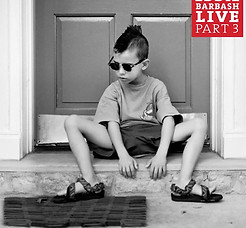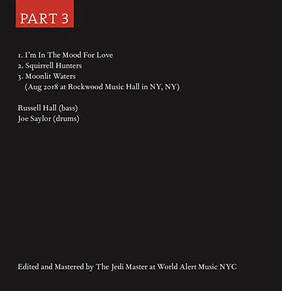
Eddie Barbash, photo: Richard Velasco
Eddie Barbash
with Philip Auslander
Alto saxophonist Eddie Barbash grew up and received his early musical training in Atlanta; he is now based in New York City. Although a jazz musician at heart, his career has seen him perform in a wide range of genres. His first group, The Amigos Band, was an Americana band that can be seen on YouTube performing an infectious Zydeco version of “Blue Moon of Kentucky,” a far cry from Barbash’s signature swing jazz sound. He has worked with jazz greats Chico Hamilton, Wynton Marsalis, and Christian McBride, and also with country luminary Vince Gill, legendary funk group Parliament, and rock musician Lenny Kravitz. He was a founding member of Jon Batiste and Stay Human, appearing with the group when it became the house band for The Late Show with Stephen Colbert. Recently, Barbash has been exploring the nexus of jazz and bluegrass; in 2019, he toured with accordionist Sam Reider and bluegrass mandolin prodigy Sierra Hull. TAS caught up with Barbash to talk with him about his time in Atlanta, his musical interests and experiences, and his life as a freelance musician.

Eddie Barbash, photo: Natalie Deryn Johnson
Philip Auslander: Did growing up in the South, specifically in Atlanta, influence you as a musician?
Eddie Barbash: I'm not sure that the culture of the South or Atlanta influenced my musical aesthetic in any traceable way, but I think that without the robust music/band program that Atlanta Public Schools had when I was young, I would not have ended up a musician. I was always around music at home and loved to listen, but had no desire at all to become a musician until I discovered the saxophone in 3rd grade band. I also would not be the musician I am had I not studied with Joe Jennings, who I think really embodies the best of Atlanta culture.

Eddie barbash in front of his home in Atlanta, Georgia
PA: Joe Jennings is a mainstay of jazz in Atlanta, an educator as well as a practicing musician. What is your take on the Atlanta jazz scene?
EB: It’s hard for me to say because I haven’t lived in Atlanta since the early 2000’s, but at that time, I got the impression that it was made up of a few big fish in a fairly small scene. Fortunately, the small handful of great players that were there were friendly and encouraging to young talent. Philip Harper is someone that was nice to me early on and would invite me to come sit in on his gigs. We met at the weekly Churchill Grounds jam session, another important part of my early development. I found it frustrating though that the Atlanta jazz scene had very few serious young musicians for me to play with and no programs for nurturing young jazz musicians. When I finally made it into the national pool via auditions to summer programs, I got jealous of my West Coast friends because they all had thriving scenes of young players back home, most of which were centered around local jazz programs.
PA: You attended the jazz program at the New School in New York City, whose saxophone faculty includes many distinguished players (including Ned Rothenberg, with whom I went to high school!). What was your experience of that program? Is there anything from that learning experience that is still with you as an artist?
EB: I transferred from Juilliard to the New School because I was looking for a place that would let me finish my degree and be a working musician at the same time. I loved the New School because they treated me like an adult. They had rigorous coursework that I knew I had to complete, but they never got in the way of my professional goals.
Eddie Barbash (sax) and Mike Barnett (fiddle) play
The New Democracy by Stuart Duncan.
PA: You have a penchant for styles of saxophone playing that evoke the 1930s and 1940s, and some of the tunes you play go back even further, to the 1920s. How did you arrive at your apparent enthusiasm for the swing era and classic jazz? What is the appeal of these styles to you?
EB: I love the pre bebop styles of jazz because they value melody. Improvisations in those styles tend to use a composition's melody as a jumping off point as opposed to just its harmony. The string band music that I love to play shares this characteristic. The first “early jazz” musician that I fell in love with was Louis Armstrong, after a friend played me his recording of “Chinatown My Chinatown.”
The Amigos Band performs "Blue Moon of Kentucky" with Brianna Thomas, Doug Wamble / Eddie Barbash on Sax
PA: Who are some of your key influences as a saxophonist (I think I hear Benny Carter, but I could be wrong!) and what do you take from them?
EB: Johnny Hodges is my all time favorite saxophonist and Benny Carter is not far behind. I love them both for their ornate, arpeggio driven styles of improvising. I particularly love Johnny Hodges for his sound and ability to inflect like a singer. I also love Coleman Hawkins, Lester Young, and Paul Gonsalves, just to name a few more.
Eddie Barbash plays "Appalachian Mountain Song" with the Dance Party
PA: You play in a wide variety of ensembles ranging in size from duos to big bands. Two questions: do you have a favorite group format? And can you talk about how it feels to play in the woodwind section a big band versus in a more intimate format? How are these experiences different from your perspective?
EB: One of my favorite formats to play in, is as a soloist accompanied by a string ensemble. I love it because it is a lush full sound that I can soar over without ever having to strain to be heard. My favorite thing about playing saxophone is manipulating my tone, and a bed of strings provides me the widest range of options, from a breathy whisper to an operatic bellow.
Duos and trios are particularly fun formats for improvising. The small size makes the ensemble much more nimble and responsive. With fewer cooks in the kitchen, things get less messy.
I do enjoy playing in a big band, but less as a soloist, and more as a member of the section. It's fun to play 2nd alto and try to “mind meld” with the sax section until we sound like one unit.
PA: I've long imagined that it must be wonderful to feel like you're helping to power a group as large as a big band. A number of historically important saxophonists have recorded with strings, including Charlie Parker, Lee Konitz, Stan Getz, Ben Webster, and Harry Carney. Do you have a favorite among these recordings?
EB: I haven’t actually heard all of those “with strings” recordings, but the two I have listened to a lot are Charlie Parker and Cannonball Adderley

Eddie Barbash on the Colbert show
PA: Your highest profile gig so far was playing with Jon Batiste and Stay Human as the house band on the Colbert show. What was your association with that group before Colbert and how did this opportunity come about?
EB: I met Jon at Juilliard in 2007 when I was a freshman and he was a senior. I started playing in his band informally that year and by the next year had become a consistent member. That was the band that taught me how to be a professional musician. I learned how to play by ear, how to learn music quickly, how to dress for gigs, how to entertain an audience, and countless ins and outs of the music business. I played with Jon from the dive bar days up through national TV. There's really no secret to how we got chosen for the Late Show. It was a lot of hustling and making the right connections on Jon's part, and countless shows played by the band that left audiences standing and shouting.
PA: You also play a wide array of genres of music that include swing, western swing, classic jazz, country, and bluegrass. Clearly, it’s unusual to hear a saxophone in the context of bluegrass. How did this come about?
EB: I fell in love with bluegrass/string band music because of its melodic approach to improvising and its virtuosity. I learned my first fiddle tune from a friend and was instantly hooked. It was a revelation to learn that there was another virtuosic, improv driven style of music that wasn't jazz, and that almost completely based its improvisations off of the melodies as opposed to the harmony of the songs.




Eddie Barbash plays Bach Sonata No. 5 for Violin and Harpsichord, 1st movement




PA: What is your life as a gigging musician like? I’m particularly interested in how you balance the performing opportunities you create for yourself with those that have you working in contexts created by others.
EB: Life as a gigging musician is exciting and maddening because nothing is consistent. It's almost impossible to plan a vacation in advance unless you just resign yourself to giving up work. It's very hard to predict months in advance how much I'll be working. The biggest challenge is deciding which gigs to take and which to turn down, because every gig you take that you don't love could potentially get in the way of taking the gig that you do love. Yet, if you turn down a gig with nothing in its place, you may not be working at all. For the last several years, I have played most of my gigs as a sideman. Band leading can be very stressful, not profitable, and is always more work, so if I can manage to get work with bands that I like, I prefer to do that.
Update: It was such a pleasure to see and hear Eddie Barbash at the Breman Museum in Atlanta on October 20, 2022. In 2020, Eddie mentioned how much he loves to play his saxophone over the “lush full sound” of a bed of strings (his words) and his enthusiasm for playing simultaneously with his jazz quartet and the KASA String Quartet on this occasion was palpable. String players and jazz players alike were integrated seamlessly into a single ensemble as they took us on a sentimental journey through the rich legacy of North American popular music of the 1940s and 1950s. This evening was a captivating evening of “live” music. --PA

Eddie Barbash plays American roots music on alto saxophone. He is a founding member of Jon Batiste Stay Human, the house band for The Late Show with Stephen Colbert. He has performed with stars in almost every genre: jazz with Wynton Marsalis, classical with Yo-Yo Ma, rock with Lenny Kravitz, country with Vince Gill, funk with Parliament, He brings his horn and sensibility to Texas and Appalachian fiddle tunes, bluegrass, old time, R&B, soul, and classic New Orleans.

Philip Auslander is the Editor of The Art Section. His seventh book, Reactivations: Essays on Performance and Its Documentation came out in 2018 and In Concert: Performing Musical Performance will be out in 2021, both from the University of Michigan Press.
